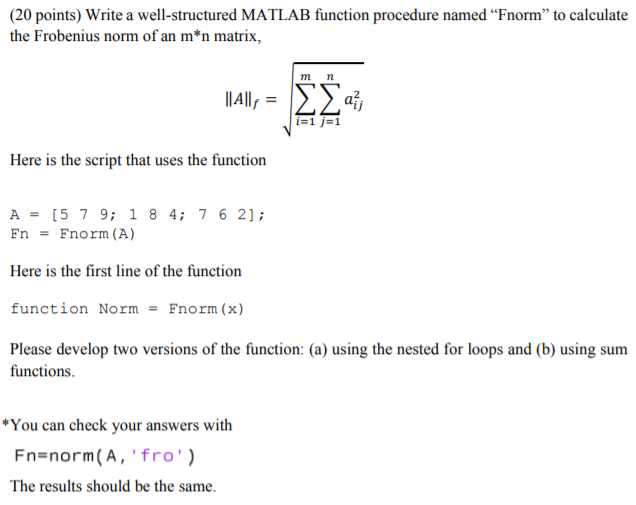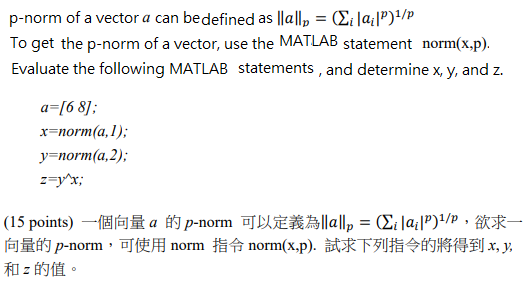

On the other hand, MATLAB uses "length" to denote the number of elements n in a vector.

Note that norm(x) is the Euclidean length of a vector x. The Frobenius-norm of matrix A, sqrt(sum(diag(A'* A))). For MIMO systems, this quantity is the peak. The Mixed-Norm Toolbox contains a complete set of routines for both. n norm (sys,Inf) returns the L norm of sys, which is the peak gain of the frequency response of sys across frequencies. This article introduces a MATLAB toolbox for fixed order, mixed-norm control synthesis.
#Matlab norm code
After thinking twice, we are now able to debug our code - just put all 3 elements into the 1st dimension. (Here, 'dimension' refers to that of the Matlab variable a vector with 3 elements in its 1st dimension is physically a 3-D vector). This value is equivalent to the H2 norm of sys. Matlab can calculate the norm of the cross product of a vector with all its information in the 1st dimension. So it norm (x) is norm (x,2) is sqrt (sum (x. The 2-norm is equal to the Euclidean length of the vector.

If X is a matrix, this is equal to the largest singular value of X. If X is a vector, this is equal to the Euclidean distance. T he infinity norm, or largest row sum of A, max(sum(abs(A'))). n norm (sys) or n norm (sys,2) returns the root-mean-squares of the impulse response of the linear dynamic system model sys. n norm (X) returns the 2-norm of input X and is equivalent to norm (X,2). The largest singular value (s ame as norm(A)). The 1-norm, or largest column sum of A, max(sum(abs(A)). Returns a different kind of norm, depending on the value of p.

There are several ways to compute xls in Matlab. The least-squares approximate solution of Ax y is given by xls (ATA) 1ATy: This is the unique x 2 Rn that minimizes kAx yk. The norm function calculates several different types of.
#Matlab norm full
Returns t he largest singular value of A, max(svd(A)). Least squares and least norm in Matlab Least squares approximate solution Suppose A 2 Rm n is skinny (or square), i.e., m n, and full rank, which means that Rank(A) n. The norm of a matrix is a scalar that gives some measure of the magnitude of the elements of the matrix. The interval xLo,xUp is the 99 confidence. x is the inverse cdf value using the normal distribution with the parameters muHat and sigmaHat. NormalizedTemp normalize (Tab, ‘norm’, Inf, ‘DataVariables’, ‘Temperature’) Using the normalize function for the table ‘Tab’. The norm function calculates several different types of matrix norms: Find the inverse cdf value at 0.5 and its 99 confidence interval. The norm of a matrix is a scalar that gives some measure of the magnitude of the elements of the matrix. So I didn't test for the for loop and Divkar's bsxfun, but you can see that for arrays smaller than 3e4 kron is better than bsxfun, and this changes at larger arrays (ratio of <1 means kron took less time given the size of the array).Norm (MATLAB Functions) MATLAB Function Reference And here it is: range=3*round(logspace(1,6,200)) Vous avez cliqu sur un lien qui correspond cette commande MATLAB : Pour excuter la commande, saisissez-la dans la fentre de commande de MATLAB. For MIMO systems, this quantity is the peak gain over all frequencies and all input directions, which corresponds to the peak value of the largest singular value of sys. So I tried to check using timeit my two solutions (because they are one liners it's easy). This MATLAB function returns the 2-norm of vector v. n norm(sys,Inf) returns the L norm (Control System Toolbox) of sys, which is the peak gain of the frequency response of sys across frequencies. Ok, this got me curios, as I know bsxfun starts to be less efficient for bigger array sizes. Here's a bsxfun solution (less elegant, but hopefully faster): 3 1])),3,)' Array assignments in MATLAB are stored as 2D arrays of double precision. This example uses norm(x)/sqrt(n) to obtain the root-mean-square (RMS) value of an n-element vector x. A slightly shorter and vectorized way will be (if a is your matrix) : b=a-kron(a(1:3:end,:),ones(3,1)) Note that norm(x) is the Euclidean length of a vector x.On the other hand, MATLAB uses 'length' to denote the number of elements n in a vector.


 0 kommentar(er)
0 kommentar(er)
